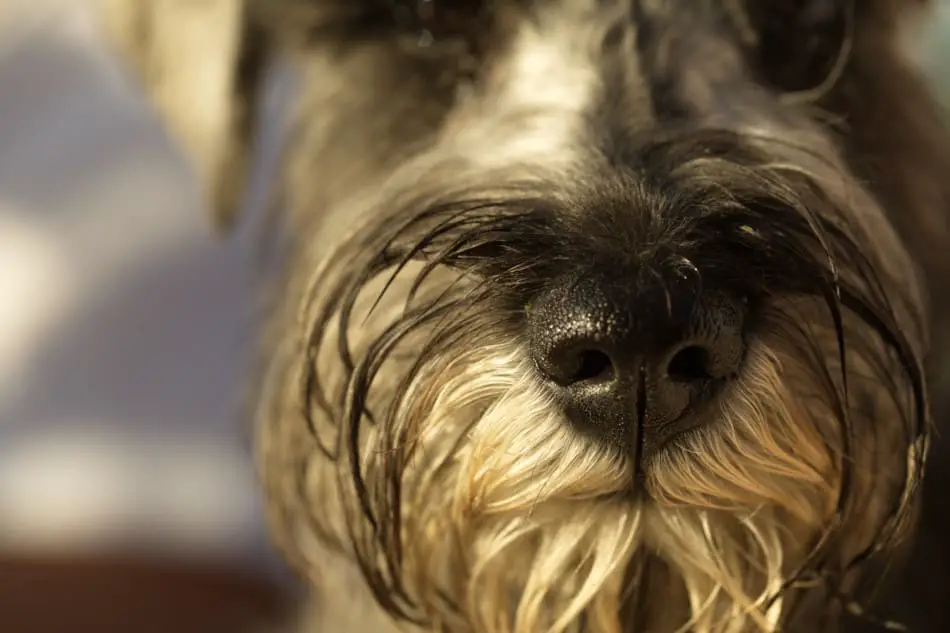It’s no secret that all dogs have an incredibly keen sense of smell. It has helped them to survive in their natural environments and has been leveraged to help humans. Schnauzers, for example, were bred to work on German farms and their sense of smell helped them track and minimize pesky rodents. But now that dogs are even more domesticated, how might their sense of smell be useful to us? Can it be harnessed to detect something as basic, yet as devastating, as human health problems?
Can Schnauzers smell human disease? Yes, it seems so. Like all dogs, Schnauzers can naturally use their powerful sense of smell to detect human diseases such as cancer and diabetes as well as conditions such as seizures, hypoglycemia, and narcolepsy. Schnauzers can also be specifically trained to detect specific diseases. More research is needed to understand and benefit from this uncanny skill.
All dogs have approximately 300 million olfactory receptors, and a significant portion of their brain is dedicated to detecting and analyzing odors in parts per trillion. This powerful sense of smell has become the subject of research, particularly in the health care sector, as experts explore ways to use it for early disease detection.
Let’s take a look at how a canine nose functions and then we’ll cover the diseases that dogs, including Schnauzers, seem to smell. You may also want to read my articles Can Schnauzers Sense Pain, Grief, and Depression? and Can Schnauzers Be Therapy or Service Dogs?
How Schnauzer’s Noses Function to Detect Illness
The canine sense of smell is incredibly powerful compared to that of human beings. Unlike humans who depend on their sight to interpret the world, dogs depend on their noses. In fact, your Schnauzer’s sense of smell is 10,000 to 100,000 times stronger than yours.
Your Schnauzer’s nose also functions differently than yours does, and those differences combine to create a very powerful tool.
Olfactory Receptors
As I mentioned above, Schnauzers have about 300 million olfactory receptors, while a human being has just 5 million receptors. The sheer number of olfactory receptors make canines useful when it comes to hunting and drug-sniffing, but their incredible sense of smell also gives them an unparalleled gift for detecting the chemical components of human biochemstry.
Separate Nasal Air Passages
Apart from the numerous scent receptors, dogs have two separate air passages: one for smelling and the other for breathing. As such, dogs can store smell in the nose even when exhaling. The process of breathing out is also somewhat different from that of humans as they draw in new molecules that help the dog identify new smells when sniffing.
Nasal Mucus
Another factor that amplifies a canine’s superb sense of smell is the mucus in its nose. The inner lining of a dog’s nose produces mucus that keeps his nostrils lubricated. As your Schnauzer inhales, a thin film of mucus that remains traps scent particles which he absorbs. This entire process enhances his ability to smell and interpret the scent.
A Brain Dedicated to Scent
Additionally, dogs have a larger olfactory cortex (40 times larger than that of humans), which enables them to detect traces of chemicals within a minute, prioritize pursuing a specific scent, and distinguish one scent from another.
This strong sense of smell also enables dogs to detect minor changes in the human body, including changes in hormones when volatile organic compounds are released by cancer cells. Researchers are looking to leverage this ability and assist in identifying a range of health conditions.
Research: How Can We Utilize the Canine Sense of Smell?
Several organizations research how a dog’s sense of smell can help detect diseases. For example, the Medical Detection Dogs organization was formed to train dogs to identify diseases by sniffing unusual odors.
The organization was established in 2008, and after a decade of training, the dogs can now be used in a clinical setting to help patients. The organization has trained the dogs to identify changes in a person’s smell caused by disease and to detect odors of specific conditions like cancer in samples such as swabs, urine, and breath.
As a result on ongoing work, the organization has trained two types of dogs:
- Medical alert dogs: These trained canines alert patients to an oncoming medical emergency to enable them to take the necessary precautions. They are useful to patients suffering from seizures, diabetes, allergic responses, and Addison’s disease. The dogs can detect slight changes in blood sugar levels and hormones, alerting the owner to quickly get medical supplies or help.
- Bio-detection dogs: They are trained to detect the smell of volatile chemicals found in fecal matter, urine, and skin swabs when you have specific illnesses. Most of these diseases cause biochemical changes in the body and the production of volatile chemicals. These kinds of dogs can detect malaria, bladder, prostate cancer, and, more recently, Parkison’s disease.
How the Dogs are Trained
The trainers use clickers and reward-based methods to fine-tune the dog’s mind. When they have identified a specific odor correctly, they are given a food treat or a play session. The dogs also work on samples in bio-detection rooms to train them to identify odors on people. This research is still ongoing, but there are positive implications for service dogs and other therapeutic settings.
Medical Conditions that Schnauzers Can Smell

Malaria
Several research studies have been conducted towards this end. The most recent, presented its findings in 2018 where researchers illustrated a dog’s ability to detect malaria from sniffing a patients socks. The investigators trained the Labrador and the Labrador-retriever for several months before it could detect the disease with precision. Dogs with this form of training can tell if a child has malaria even without showing symptoms.
Cancer
Research shows the dogs can detect breast cancer, skin, and bladder cancer. A study published on the BMJ Case Reports described how a 75-year-old man visited a doctor after his dog had licked a lesion persistently behind his ear.
Malignant Melanoma
Upon making diagnostic tests, the doctor confirmed malignant melanoma. While the dog was not trained to detect cancer, it had identified the condition with accuracy.
Colorectal Cancer
Trained dogs can also detect colorectal cancer by sniffing on a person’s breath and watery stool even during the early stages of the disease.
Lung Cancer
Studies also show the dogs can detect lung cancer from a person’s breath. One particular study found that a trained dog exhibited a high rate of accuracy when distinguishing between the breath of a person with and without lung cancer.
Prostate Cancer
Dogs are also believed to detect prostate cancer. In a study conducted by Italian researchers, two German shepherds had been trained to detect chemicals associated with prostate cancer. The researchers found that the dogs were correct in 90% of the cases.
Breast Cancer
It is also possible for dogs to detect breast cancer. Buckinghamshire Healthcare NHS is conducting trials to determine their ability to detect the disease from a woman’s breath.
Narcolepsy
Narcolepsy is a condition that affects the brain leading to disruption in one’s sleep-wake cycles. As such, a person can suddenly fall asleep in the middle of a conversation or a task. Narcolepsy is dangerous as people experiencing attacks can fall or cause an accident when driving.
A study found that dogs can pick up the biochemical changes in the body when the attack is about to happen. During the investigation, two trained dogs detected 11 of 12 narcolepsy patients using sweat samples. The untrained control dogs only detected 3 of the 12 narcolepsy patients.
The service dogs helping people with this condition perform a range of activities to alert the patients. They can stand over the patient to protect him if the attack happens in public. Also, they can stand over your lap before the attack happens to prevent you from falling on the floor. What’s more, they are can be trained to warn you five minutes before the attack happens.
Large dogs are particularly helpful as they are trained to give the patient extra support in mobility and balance after the attack.
Diabetes
Dogs are used by diabetic patients to detect low and high blood sugars. Hypo Hounds, a non profit organization, trains dogs to detect the levels by sniffing an individual’s breath. Studies show that trained dogs can detect the problem earlier than a glucose-monitoring device.
A study published in Diabetes Care Journal found that the dogs detect isoprene, a natural chemical in human breathe that increases when you have low blood sugar levels. Researchers believe that dogs sensitive to this chemical can tell when the patient’s body produces it at high levels.
A report on the Medical News Today shows that the dogs are trained to differentiate between scent from a previous and a current episode. They alert the person giving the patient time to test blood sugar level and take medication.
While there is much skepticism regarding the effectiveness of an alert dog, diabetic patients living with trained dogs find them quite helpful.
Migraines
Having alerts about an oncoming episode makes the difference between managing the problem and succumbing to hours of intense pain. A research study demonstrated that dogs change behavior before or during migraine episodes. The survey which involved 1027 dog owners found that 54% of them changed behavior.
Seizures
There has been growing evidence showing dogs can detect an oncoming seizure episode. Research is still being conducted to prove the effectiveness of alert dogs, and clinicians are yet to identify ways to train dogs to detect the problem. Trials and research results have found that dogs can identify an epileptic seizure odor.
The studies were conducted on a handful of dogs sniffing odor samples collected during a seizure. The researchers concluded that much more research and testing was required to find out if the dogs would respond the same way, and if the dogs could predict seizures before it happened.
Parkinson’s Disease
It has been proven that people with this condition develop a unique scent years before the symptoms are apparent. This phenomenon was suggested when a woman living in Perth, Scotland, claimed that her husband’s smell had changed slightly several years before he developed difficulty in movement.
It is this discovery that prompted researchers at Manchester University to train dogs to detect Parkinson’s disease. The trials are still in process as the scientists have not yet identified the odor molecules associated with the illness. However, work on the molecules continues so that dogs can ultimately be trained to offer early detection.
While both lab results and first-hand patient experiences are still evolving, it appears that dogs can innately sense problems and specifically be trained to identify human disease.
Some of the limitations stem from our own human ability to decipher exactly which biochemical changes dogs should be trained on. Many studies are still in the development stages as scientists have not identified the actual odor molecules to use to train dogs to identify specific diseases.
However, research looks promising in many cases and service dogs have been useful to their human companions…even to the point of saving lives.
And finally, from one pet parent to another, discover my all-time favorite resources designed to cover your every Schnauzer need. I’ve done the legwork for you so you can spend more time with the people and fur friends in your life.
A portion of all profit earned on this site is donated to Pet Partners
whose mission is to improve human health and
well-being through the human-animal bond.
They train and register pets to become therapy animals,
and have local chapters in many states.

